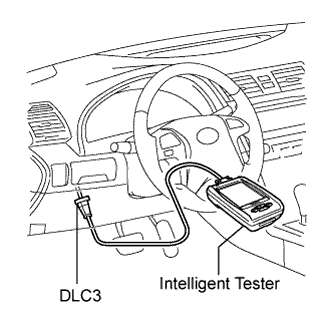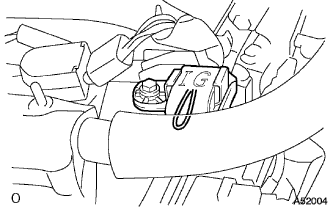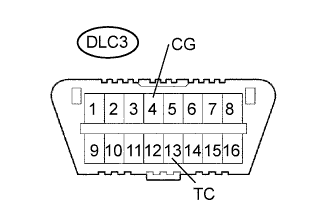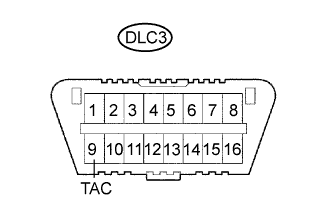Engine -- Inspection |
| 1. INSPECT ENGINE COOLANT |
Inspect the engine coolant (CAMRY_ACV40 RM000000V1Q01EX.html).
| 2. INSPECT ENGINE OIL |
Inspect the engine oil (CAMRY_ACV40 RM000001R0T01TX.html).
| 3. INSPECT BATTERY |
Inspect the battery (CAMRY_ACV40 RM000001AR900IX.html).
| 4. INSPECT SPARK PLUGS |
Inspect the spark plugs (CAMRY_ACV40 RM000001QVP03SX_01_0002.html).
| 5. INSPECT AIR CLEANER FILTER ELEMENT SUB-ASSEMBLY |
Remove the air cleaner filter element sub-assembly.
Visually check that there is no dirt, blockage, and/or damage to the air cleaner filter element.
- HINT:
- If there is any dirt or a blockage in the air cleaner filter element, clean it with compressed air.
- If any dirt or a blockage remains even after cleaning the air cleaner filter element with compressed air, replace it.
| 6. INSPECT IGNITION TIMING |
Warm up the engine.
When using the intelligent tester:
Check the ignition timing.Connect the intelligent tester to the DLC3.
Enter DATA LIST MODE on the intelligent tester.
- Ignition timing:
- 8 to 12° BTDC at idle
- HINT:
- Refer to the intelligent tester operator's manual for help when selecting the DATA LIST.
 |
When not using the intelligent tester:
Check the ignition timing.Using SST, connect terminals 13 (TC) and 4 (CG) of the DLC3.
- SST
- 09843-18040
- NOTICE:
- Confirm the terminal numbers before connecting them. Connection with a wrong terminal can damage the engine.
- Turn off all electrical systems before connecting the terminals.
- Perform this inspection after the cooling fan motor is turned off.
Remove the No. 1 engine cover.
Pull out the wire harness as shown in the illustration. Connect the clip of the timing light to the wire harness.
- NOTICE:
- Use a timing light which can detect the first signal.
- After checking, be sure to tape the wire harness.
Check the ignition timing at idle.
- Ignition timing:
- 8 to 12° BTDC at idle
- NOTICE:
- When checking the ignition timing, the transmission should be in neutral.
- HINT:
- After engine rpm is kept at 1,000 to 1,300 rpm for 5 seconds, check that it returns to idle speed.
Disconnect terminals 13 (TC) and 4 (CG) of the DLC3.
Check the ignition timing at idle.
- Ignition timing:
- 5 to 15° BTDC at idle
Confirm that the ignition timing moves to the advanced angle side when the engine rpm is increased.
Remove the timing light.

 |
| 7. INSPECT ENGINE IDLE SPEED |
Warm up the engine.
 |
When using the intelligent tester:
Check the idle speed.Connect the intelligent tester to the DLC3.
- HINT:
- Refer to the intelligent tester operator's manual for further details.
Enter DATA LIST MODE on the intelligent tester.
- Idle speed:
Item Specified Condition M/T 650 to 750 rpm A/T 610 to 710 rpm
- NOTICE:
- When checking the idle speed, the transmission should be in neutral.
- Check the idle speed with the cooling fan off.
- Switch off all accessories and air conditioning before connecting the intelligent tester.
When not using the intelligent tester:
Check the idle speed.Using SST, connect the tachometer tester probe to terminal 9 (TAC) of the DLC3.
- SST
- 09843-18030
Check the idle speed.
- Idle speed:
Item Specified Condition M/T 650 to 750 rpm A/T 610 to 710 rpm
 |
| 8. INSPECT COMPRESSION |
Warm up and stop the engine.
Disconnect the injector connectors.
Remove the ignition coils.
Remove the spark plugs.
Check the cylinder compression pressure.
Insert a compression gauge into the spark plug hole.
Fully open the throttle.
While cranking the engine, measure the compression pressure.
- Compression pressure:
- 1.360 MPa (13.9 kgf/ cm2, 198 psi)
- Minimum pressure:
- 0.98 MPa (10 kgf/ cm2, 142 psi)
- Difference between each cylinder:
- 100 kPa (1.0 kgf/ cm2, 14 psi)
- NOTICE:
- Always use a fully charged battery to obtain an engine speed of 250 rpm or more.
- Check the other cylinders' compression pressure in the same way.
- This measurement must be done as quickly as possible.
If the cylinder compression is low, pour a small amount of engine oil into the cylinder through the spark plug hole and inspect again.
- HINT:
- If adding oil increases the compression, the piston rings and/or cylinder bore may be worn or damaged.
- If pressure stays low, a valve may be stuck or seated improperly, or there may be leakage in the gasket.
 |
| 9. INSPECT CO/HC |
Start the engine.
Run the engine at 2,500 rpm for approximately 180 seconds.
Insert the CO/HC meter testing probe at least 40 cm (1.3 ft) into the tailpipe during idling.
Immediately check CO/HC concentration at idle and/or 2,500 rpm.
- HINT:
- Complete the measuring within 3 minutes.
- Check regulations and restrictions in your area when performing 2 mode CO/HC concentration testing (engine check at both idle speed and at 2,500 rpm).
If the CO/HC concentration does not comply with regulations, troubleshoot in the order given below.
Check A/F sensor operation (CAMRY_ACV40 RM0000012OG006X_01_0001.html).
See the table below for possible causes, and then inspect and repair.
CO HC Problems Causes Normal High Rough idle - Faulty ignitions:
- Incorrect timing
- Fouled, shorted or improperly gapped plugs
- Incorrect valve clearance
- Leaky intake and exhaust valves
- Leaky cylinders
Low High Rough idle
(fluctuating HC reading)- Vacuum leaks:
- PCV hoses
- Intake manifold
- Throttle body
- Brake booster line
- Lean mixture causing misfire
High High Rough idle
(black smoke from exhaust)- Restricted air filter
- Plugged PCV valve
- Faulty SFI system:
- Faulty pressure regulator
- Defective engine coolant temperature sensor
- Defective MAF meter
- Faulty ECM
- Faulty injectors
- Faulty throttle position sensor
- Faulty ignitions: